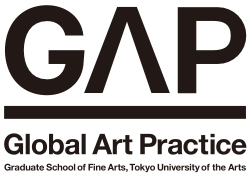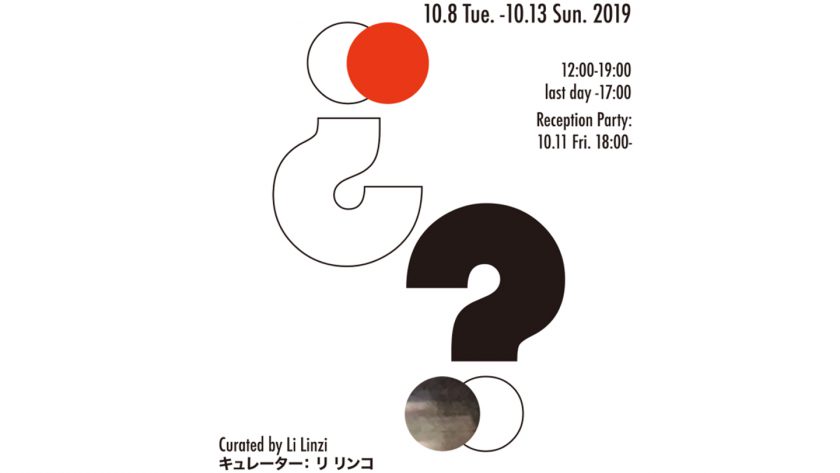ルアンルパが2000年の創設以来、ジャカルタというコンテクストの中でどのように19年に渡って活動をしてきたかを振り返ります。そして個人のアーティストとして、同時にコレクティブとして、どのようにアイデンティティを作り上げてきたか、そして彼らの活動をインドネシアの社会のなかでどのように位置づけて来たかについて語ります。
“space as a form and place where we take part in distributing knowledge and experience”
A look back on the activities of the artist collective, ruangrupa, in the context of Jakarta over the course of 19 years since its foundation in 2000 to the present. The guest lecturers will be discussing the dynamics of being considered as both an individual artist and as part of a collective. They will discuss how they have managed to create their identity and how they have established and positioned themselves in Indonesian society.
Date:Thursday, 17 October 2019, 6:00 p.m. – 8:00 p.m. (JST)
日時:2019年10月17日(木)18:00-20:00
Venue:Lecture room 3, 2F Chuo-Building, Ueno Campus Tokyo University of the Arts, 12-8, Ueno Park, Taito-ku, Tokyo
会場:東京藝術大学上野校地中央棟2F 第3講義室 東京都台東区上野公園12-8
東京藝術大学大学院美術研究科グローバルアートプラクティス専攻(GAP専攻)では、ジャカルタを拠点に活動するアーティスト・コレクティブ「ルアンルパ」を招いて、公開講義を開講します。
今回はメンバーであるイスワント・ハルトノとレザ・アフィシナが来日し、10月17日から21日まで社会実践論の授業を担当します。
今年2月にドクメンタ15(2022)のアーティスティック ディレクターに選出されて、大忙しのルアンルパですが、今回、特別に授業を担当して頂けることになりました。
17日は公開講義ですので、どなたでも聴講できます。みなさまお誘い合わせの上、ぜひご参加ください。
“ruangrupa Artist Collective Elected as Artistic Director of Documenta 15”
February 22, 2019. In a surprising turn of events, an artist collective was named as Artistic Director – a first in the history of Documenta. Past Documentas were always directed by very influential curators from around the world. These were the individuals who were charged with leading this event that happens only every 5 years. This marks the first time that an artist collective has been charged to curate Documenta, and the very first time that Asian artists have been tapped to take the lead.
In the early 2000s, several Asian alternative movements such as Art Archive and Tokyo Wonder Site began to form. ruangrupa, the art collective established by Jakarta-based artists in the year 2000 is one of them.
Indonesia in the 90s. The Asian Financial Crisis that began in 1997 triggered unemployment and inflation rates to skyrocket. The tragic May 1998 riots resulted in violence and the deaths of many Indonesian citizens. Suharto the Indonesian Military leader and politician who held the office of the president finally resigned after 31 years. The social and economic instability and anti-government demonstrations in the late 90s became the catalyst for the formation of collectives and organizations questioning the existing social system.
As an artist collective, ruangrupa has been taking different roles in a variety of activities. They are artists, curators, editors, educators and activists. Members of the collective are not bound by any specific role thus giving each individual the freedom to participate and lead as they see fit. Their activities range from managing art spaces, exhibitions, workshops and research projects to organizing community radio station, RURU radio. Recently, they have co-initiated GUDSKUL: Contemporary Art Collective and Ecosystem Studies. This is a public learning space created to practice and expand understanding of collective values such as equality, solidarity, etc.
19 years ago, runagrupa began with just 6 people. Currently, the collective has 30 members.
ruangrupa questions the authoritative and conservative definition of “artist.” As a collective, their activities are flexible and develops organically, unlike the one-off movements created in the 1960s. They are challenging the new collectives to think about how to grow naturally and maintain the ideals of sustainability in both the local and global context. This is not about creating a new elite. This is about creating a space where everyone can come and go as they please. “Ruang” means field and space while “rupa” means form. This collective is trying to form a new space – a platform where artists use their sensitivities to review diverse issues in society, history and politics.
Creating a “smart and tactical strategy.” That is how ruangrupa approaches issues surrounding government policies. Opposing these policies by simply attacking the government is not effective. They believe that creating a way to communicate and negotiate is the key.
They believe that simple thoughts and actions are vital when dealing with the myriad of issues across the globe. It is also more important to embrace friendship rather than make art. Perhaps it is because of this progressive way of thinking that ruangrupa was chosen by the Documenta Selection Committee. The committee must have felt the potential to initiate a positive change for the present and the future of the arts – namely for art to go beyond the small world of art. The collective has begun preparing for Documenta by visiting Kassel over the course of several months. It will be really exciting to see how they will change things for the 2022 Documenta.
Finally, I would just like to quote their answers when asked in an interview about collectivism. It is a rare thing for people to think that the current system is changeable, taking for granted the moments we have that last mere decades. I am thinking especially of the social situation in Japan now, where the status-quo is not questioned. It is hard to find Japanese people really contemplating on what an “original” society should look like or how our social system should evolve in the future. Within the present society where we face many challenges, I think that we can all discover new ideas that can tackle these challenges through the activities of ruangrupa. Their works, events, movements and practices that take into account the relationship of art and society in a broader perspective and their emphasis on making friends rather than enemies will provide great insight for everyone, thus maintaining hope for a more positive future.
“So collectivism is a small-scale way for us to constantly challenge institutions and question how we live together. It is a way of speculating about things. It gives us the luxury to speculate. Not many people in society today have that luxury, because they can’t afford it. There are too many risks. In general, we can’t afford to change how we live. No one wants to speculate about it, because it’s too risky. But through collectivism, we have the luxury of being able to think that way.”(interview by ART-iT)
Yusaku Imamura, Professor
Global Art Practice, Graduate School of Fine Arts
Tokyo University of the Arts
=========================
ruangrupa
ruangrupa – always written using lowercase letters and without spaces – is a contemporary art organization and artist collective founded in 2000 by a group of artists based in Jakarta, Indonesia. This collective started as a contemporary art ecosystem that was developed from a nonprofit work model. As an NPO lead and founded by creatives, ruangrupa is involved in wide-ranging initiatives including operating the art space that they use as their headquarters, holding exhibitions and workshops, conducting research as well as directing international exhibitions.
In 2019, ruangrupa worked together with 2 artist collectives: Serrum and Huru Hara to initiate Gudskul: Contemporary Art Collective and Ecosystem Studies. This is an educational platform aimed at maximizing learning opportunities surrounding the arts in the forms of collaboration and sharing.
Another facet of their art ecosystem is the ArtLab which is a program that examines art projects and perform creative collaborations. These usually deal with urban issues and the media. ArtLab aims to be a space for individual artists or interdisciplinary groups from within and outside Indonesia to interact and work together.
ISWANTO HARTONO, FLOWER, 2008
Iswanto Hartono & Reza Afisina
Jakarta-based artists part of the ruangrupa artist collective. Together, they established a conceptual duo: RAIH.
Iswanto Hartono is an Indonesian artist with a background in architecture. Since the late 90s, he has been showing works with strong social and political content. His interests lie in history/memory, globalization, geopolitical powers, post-colonialism and race/identity. However, he is particularly interested in a country’s history that have been consciously forgotten. He currently lives and works in Jakarta, as an artist, architect, curator and writer.
Reza Afisina is a new media artist utilizing performance art in his practice. He co-curated TRANSaction: Sonsbeek 2016 held in Arnhem, Netherlands. In 2018, he served as an interlocutor for the Asia Pacific Triennial. He has been the director of ArtLab since 2008.
「ルアンルパがドクメンタ15のアーティスティック・ディレクターに選出される」
2019年2月22日、ドクメンタから驚きのニュースが発信された。これまでドクメンタといえば、パワーキュレーターたちが世界の潮流を5年に一度世に知らしめるという形で行われたきた。しかし、ついにアーティスト・コレクティブによりキュレーションされる時が来たのだった。しかもアジアで活動するアーティストたちによって。
ルアンルパは2000年にジャカルタでアーティストたちによって形成されたコレクティブだ。アジア・アート・アーカイブ、トーキョーワンダーサイトをはじめ、アジアの多くのオルタナティブムーブメントが、この頃にスタートしている。ルアンルパもその一つだ。活動の母体はすでに90年代後半にあり、その背景には97-98年におけるアジア通貨危機をきっかけに大きな失業やインフレが生まれた社会危機と98年のジャカルタの学生運動から始まった反政府デモ、スハルト退陣がある。既存の社会制度に疑問を持ち、自分たちで新たなシステムを作り上げるために共同して活動が始まった。
彼らの活動は、アーティスト、キュレーター、エディター、教育者、アクティビストと幾つもの側面を持つ。メンバーの誰もが領域に区切りも持たずに活動し、アートスペースの運営、展覧会やワークショップ、リサーチプロジェクトから、Ok video festivalなどの国際展の企画運営に加え、アートショップやコミュニティラジオ局RURUradioなども展開するなど、その活動は多岐にわたる。近年、本格的な学校づくりに取り組みGUDSKULを開設している。設立当初は6人から始まったが、他のコレクティブとの共同も始まり、19年を経た現在では30名もの活動に広がっている。
ルアンルパは、これまでに作り上げられたアーティストという権威的な一つの定型を疑う。活動はフレキシブルで有機的で、60年代のような一度きりのムーブメントではなく、新しい有機的な動きがいかに持続可能でローカルでかつグローバルなものであり得るかという新しいコレクティビティを問うている。しかもそれは新たなエリートを生むのではなく、誰もが出入り自由な場を作り上げようとしている。 「ルアン」が場と空間を意味し、「ルパ」が形作ることを意味するように、ルアンルパは新たな場の形成を試みているのである。そのプラットフォームは歴史や政治や多様な社会の問題をアーティストのセンシティビティによって見直すものだ。
彼らは政府の政策に反対するときも、いかにそれにコントラストを示す別のアクティビティで対応するか、「スマートで戦略的な方策」を考えるという。そこでコミュニケートし、ネゴシエートするやり方を生み出そうとする。攻撃ばかりでは有効ではない、と彼らは言う。
世界の様々な問題に対応するためにシンプルな考えと活動が重要だ、作品を作る以上に友を作り、それを大切に思うこが重要だ、と彼らは言う。ドクメンタの芸術監督選出の審査員たちは、彼らの活動と思想にアートの現在をそして未来への可能性を感じたのだろう。そしてアートという枠を超えることも。彼らはカッセルに数ヶ月滞在をして準備を始めているという。今後の活動に目が離せない。
最後に彼らがコレクティビズムについて、インタビューで聞かれた時の答えを引用したい。人は当たり前に思っていることが実はほんの数十年のことであったり、今の制度が変更可能であると考えることは少ない。特に現状追認が日常化してしまった現在の日本では、なかなか本来の社会や来るべき社会について考えることは少なくなってしまった。多くの課題を抱えた現代社会のなかで、ルアンルパのように大きな視野でアートと社会を考え、攻撃よりも友を作ることに意義を見出す活動に、私たちの未来にとって大きな示唆があると思うのである。
“So collectivism is a small-scale way for us to constantly challenge institutions and question how we live together. It is a way of speculating about things. It gives us the luxury to speculate. Not many people in society today have that luxury, because they can’t afford it. There are too many risks. In general, we can’t afford to change how we live. No one wants to speculate about it, because it’s too risky. But through collectivism, we have the luxury of being able to think that way.” (interview by ART-iT)
東京藝術大学大学院美術研究科グローバルアートプラクティス専攻
教授・社会実践論担当
今村有策
———————————————
「ルアンルパ:インドネシアにおける現代の都市問題に批評的観察眼を持って対峙し、社会学、政治、テクノロジー、メディアなどあらゆる分野の思考や実践を横断しながらアートの創造性を駆使して、都市やその文化的課題に応答する活動を展開している。拠点となるアートスペースを運営し、展覧会やワークショップ、リサーチ業務から、Ok video festivalなどの国際展の企画運営やアートラボ、各種リサーチプロジェクトの実践に加え、アートショップやコミュニティラジオ局RURUradioなども展開するなど、その活動は多岐にわたる。また、書籍やアートマガジン、DVDやウェブマガジンの発行など、情報発信とアーカイブ活動にも従事している。第31回サンパウロ・ビエンナーレ(2014)では会期中都市を巻き込むかたちでアートスペースを展開し注目を集めた。」(あいちトリエンナーレ2016での紹介)
私がトーキョーワンダーサイトの館長時代には、アジアのオルタナティブスペースの集まりや、世界各地での会議で一緒になり、幾度も意見交換を行なってきた。今回招聘する講師の一人である、イスワント・ハルトノは2008年にトーキョーワンダーサイトのアーティスト・イン・レジデンスに滞在。「アートの課題」という多文化社会とアートセンターの役割を問うプロジェクト(共催:ドイツ文化センター他)の第1回「What geme shall we play today?」に参加して制作、討議を行っている。
Lecturer:
Iswanto Hartono & Reza Afisina(ruangrupa)
ゲスト講師:
イスワント・ハルトノ、レザ・アフィシナ(ルアンルパ)
社会実践論1 担当:今村有策(GAP専攻・教授)
※日英逐次通訳あり 通訳 水田拓郎 / dj sniff



